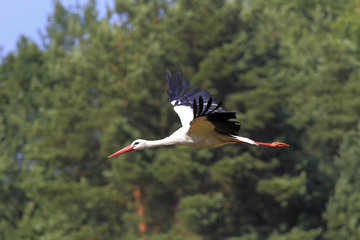"Smoking" Rain Clouds over the Amazon
Forest fires in the Amazon rainforest intensify turbulence in the weather and could have global impact
Several hundred thousand deforestation and agricultural fires burn during the dry season in the Amazon each year, peaking in September and October, and covering vast areas with dense smoke. The first results from SMOCC (Smoke, Clouds, and Climate), an international research project led by Prof. Dr. Meinrat O. Andreae of the Max Planck Institute for Chemistry in Mainz, show that smoke from these fires has a greater impact on weather and climate than was previously known. The smoke affects the formation of clouds, changes the behaviour of precipitation, and induces thunderstorms and hail. The changed cloud properties also lead to warming of layers higher up in the atmosphere and to transport of pollution to these layers, which can have more global impacts on climate (Science, 27 February 2004).
Small particles in the air, so-called aerosols, are important for the formation of clouds. Cloud droplets form by condensation of water vapour on these particles, and without aerosols in the atmosphere, clouds cannot form. Aerosols are formed both in natural and human processes. Since the industrial revolution, the number of human-produced particles in the atmosphere has increased drastically. The effect of these particles on the atmosphere and the climate has therefore been of great scientific interest for decades. One impact of the particles is that they reflect sunlight and prevent the sun from heating the Earth’s surface. This has a cooling effect on the climate. Another impact is that the particles can change the properties of clouds and precipitation, which is more difficult to understand, but ultimately also has a cooling effect on the climate. Together, these cooling effects may have cancelled a significant fraction of the greenhouse gas warming over the past century.
In the natural environment, the number of particles in the atmosphere is rather low. When clouds form, the number of cloud droplets will therefore also be low. On the other hand, in polluted air, the number of aerosol particles is much higher, and therefore the number of cloud droplets in clouds over polluted regions will be much higher. Clouds with a high number of droplets, but of smaller size, are more efficient in reflecting sunlight, and will thus, in the same way as the direct effect of aerosols, have a cooling effect on the Earth.

An increase in the number of the droplets is accompanied by a decrease of their size, since the amount of the condensable water vapour does not change. But smaller droplets do not easily collide with one another, which is necessary to form rain. Thousands of cloud droplets have to collide, in order to form a drop that is large and heavy enough to fall to Earth as a raindrop. The scientific project SMOCC (Smoke, Clouds, and Climate) has focused on this latter aspect. "We try to understand more about how the vast amount of aerosol particles, produced by deforestation in the Amazon, will affect clouds, weather and climate", says Meinrat O. Andreae.
The research team has found that the smoke from human induced fires indeed reduced the cloud droplet size dramatically. Due to this, precipitation was suppressed, and when it occurred, the onset of the precipitation was delayed from about 1500 meter above cloud base in unpolluted clouds to more than 7000 meter above cloud base in pyro-clouds (see Fig. 1). Also clouds that grew out of the polluted smoke haze, so-called smoky clouds, showed considerable suppression and delayed onset of precipitation.

The delayed onset of precipitation leads to the transport of heat to higher layers in the atmosphere. Heat is released to the air when water vapour condenses on the aerosol particles, and when liquid water freezes to ice. At the higher elevations the temperature is cold enough for water to freeze.The heat released at these higher elevations will reinforce the updraft of the air and lead to more intense turbulence, which will make the cloud more vigorous and can induce stormy weather, thunderstorms, lightning, heavy showers and hail. Hail stones as large as two centimeters in diameter has been reported from these cloud types.
Other effects of the suppressed and delayed onset of precipitation are that the heat released at high altitudes can induce substantial changes in the regional and global circulation of air. In addition, aerosol particles, water vapour, and gaseous pollutants can be transported through these clouds to high elevations in the atmosphere, where they can spread over much larger regions, possibly all over the entire globe. Thus, these effects can have more global impact, which will be studied in more detail in the future.













